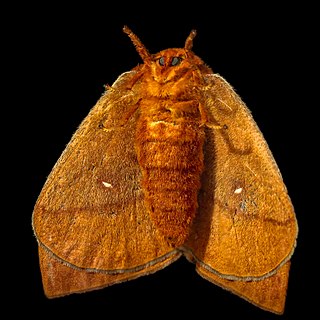Automeris zephyria, the zephyr eyed silkmoth, is a species of insect in the family Saturniidae. It is found in North America.
Hemileuca hualapai, the hualapai buckmoth, is a species of insect in the family Saturniidae. It is found in Central America and North America.
Saturnia mendocino, the Mendocino saturnia moth, is a species of silkmoth in the family Saturniidae. It was first described by Behrens in 1876 and it is found in North America.

Hemileuca burnsi, the Burns' buckmoth, is a species of insect in the family Saturniidae. It is found in North America.
Automeris cecrops, the cecrops eyed silkmoth, is a species of insect in the family Saturniidae. It is found in Central America and North America.
Hemileuca chinatiensis, the chinati sheepmoth, is a species of insect in the family Saturniidae. It is found in North America.
Automeris patagoniensis, the Patagonia eyed silkmoth, is a species of insect in the family Saturniidae. It is found in North America.
Hemileuca stonei, the pangola-grass moth or Stone's buckmoth, is an insect in the family Saturniidae. The species was first described by Claude Lemaire in 1993. It is found in Central and North America.
Saturnia albofasciata, the white-streaked saturnia moth, is a species of silkmoth in the family Saturniidae. It's endemic to California.
Automeris iris, the iris eyed silkmoth, is a species of insect in the family Saturniidae. It is found in Central America and North America.
Hemileuca oliviae, the range caterpillar, is a species of insect in the moth family Saturniidae. It is found in Central America and North America.

Hemileuca juno, the Juno buck moth, is an insect in the family Saturniidae. The species was first described by Alpheus Spring Packard in 1872. It is found in Central and North America.
Saturnia walterorum, or Walter's saturnia moth, is a species of silkmoth in the family Saturniidae. It is found in Central America and North America.

Hemileuca neumoegeni, or Neumoegen's buckmoth, is a species of insect in the family Saturniidae. It is found in North America.
Anisota manitobensis, the Manitoba oakworm moth, is a species of royal moth in the family Saturniidae. It is found in North America, primarily Manitoba.
Coloradia luski, or Lusk's pine moth, is a species of insect in the family Saturniidae. It was first described by William Barnes and Foster Hendrickson Benjamin in 1926 and it is found in North America.
Hemileuca grotei, or Grote's buck moth, is a species of insect in the family Saturniidae. It is found in North America.

Anisota consularis, the Florida oakworm moth or consular oakworm moth, is a moth in the family Saturniidae. The species was first described by Harrison Gray Dyar Jr. in 1896. It is found in North America.
Hemileuca griffini, known generally as the Griffin's sheepmoth or Canadian fleabane moth, is a species of insect in the family Saturniidae. It is found in North America.

Agapema homogena, commonly known as the Rocky Mountain Agapema, is a species of giant silkmoth in the family Saturniidae. It is found in Central America and North America.




